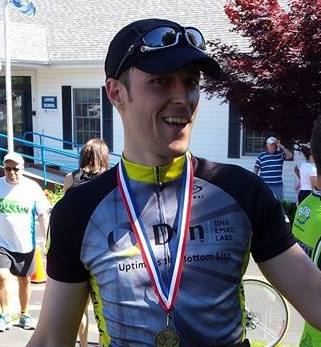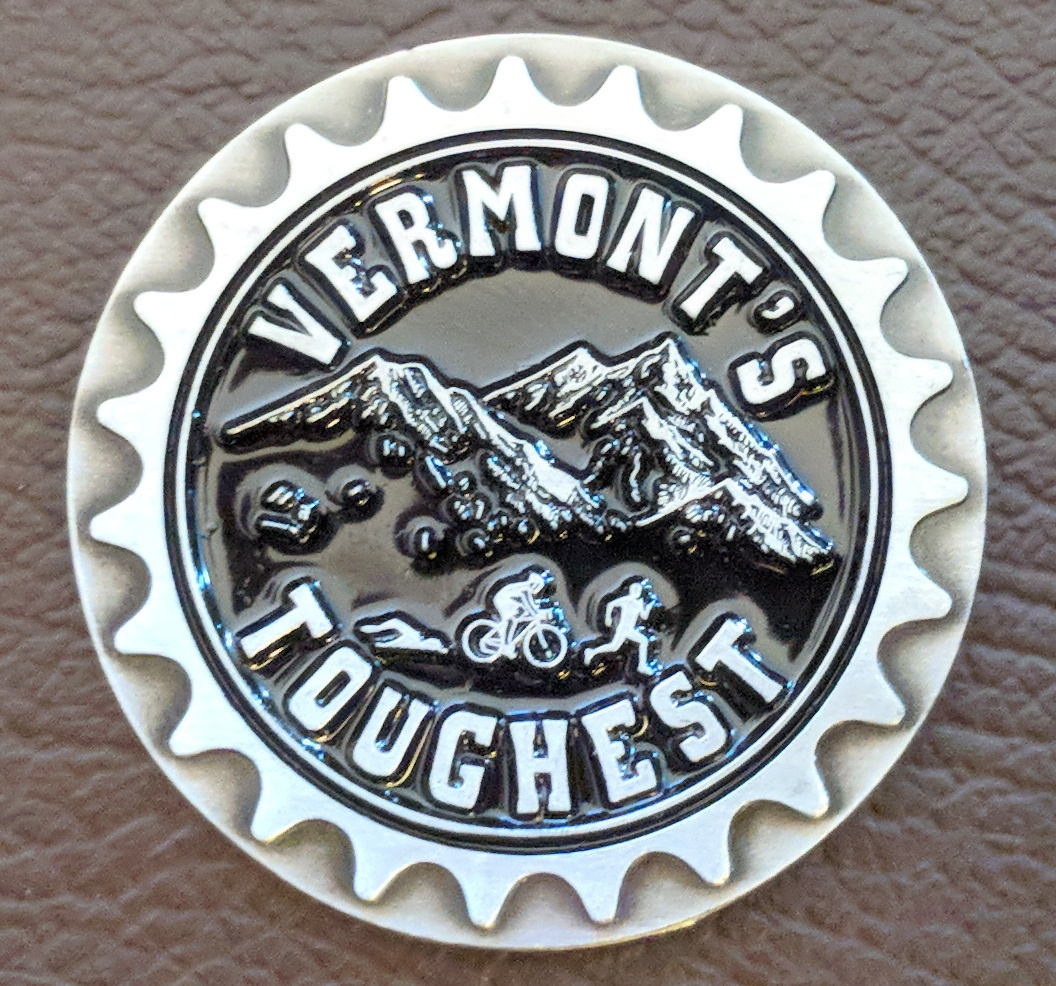
Most triathletes have at least some awareness of James Lawrence, also known as "IRONCOWBOY", with many having followed James' story as he completed an unthinkable 50 full iron distance races, in all 50 states of the USA, in 50 consecutive days in 2015.
But, did you know that James has begun his own race series at www.ironcowboyracing.com? Their aim is to be a different kind of race in contrast to the more and more corporate vibe of many well known full distance triathlons today.
They're self supported. They're scenic. They have a grass-roots feel, and yes, they're tough. These aren't courses made to cover 140.6 miles as quickly as you can. These are challenging courses designed to push you to your limits, to give you a one-of-a-kind experience, and to encourage competitors and support crews to cheer each other on. The mentality is generally people competing against the course rather than each other (though there's that too, of course).
Inaugural Year
2018 was the first year of the Vermont's Toughest Triathlon, and the intention was to do a smaller group "test run" of everything to work out any kinks for future years. That meant that registration didn't open until closer to the event, and wasn't advertised as heavily as many full distance triathlons. It was also much less expensive for both registration and hotel compared to other triathlons, which left many folks who had already signed up for something else close to the same date kicking themselves.
I myself was signed up for IRONMAN Lake Placid the following weekend, but eventually decided it felt more than a little silly to be concerned about 2 races a week apart at an event organized by someone who did 50 in a row.
Still, many folks said I was nuts to do that, and I ended up hedging things by doing the swim and bike of a relay team, with my friend Sarah doing the run, thinking that the run would be the hardest thing to recover quickly from. Luckily Sarah was game!
Training and Events
I often hear that I shouldn't do as many events as I do, warning that I'm never fresh, need to be taking more time to recover, and be following more of a standard training plan. When I've tried to go by some set plan, it just takes the fun out of it for me.
But the truth is, whenever I do eventually just do something despite warnings not to, it's gone fine, sometimes I set PRs. Going by how I feel, both physically and mentally, for both training and races rather than any kind of set formula, has worked really well for me. Sometimes it just takes me a bit to get over the mental barrier of many people telling me I shouldn't do something.
I figure there's no guarantee for how long I'll be able to do things like this, you never know what could happen. Doing just one or two "A" races a year foregoing much else just seems like missing out on a lot of experiences I could have.
My social life has evolved over the years. I have a lot of fun training and adventuring, but it takes a lot of time, so sometimes training with friends or doing events accounts for a lot of my social interaction these days. I do a lot of events for that reason and just count them towards training for other things.
I don't really train so much to do races, as I do races because I'm training enough for them anyway.
Like Mindset

So, while my mindset for training and events isn't as common in general, it fit right in at Vermont's Toughest. Other athletes participating had done other full distance races within the past couple of weeks, others were planning to do more soon, and no one batted an eye at doing Lake Placid the next weekend. For James especially, a week between races is practically a vacation. Just think of how much sleep you can catch up on!
It was refreshing to be around others like that. I mentioned Lake Placid the next weekend to more people than I ever normally would, I think just to enjoy the accepting responses rather than being told I shouldn't.
Venue at the Burke Mountain Hotel
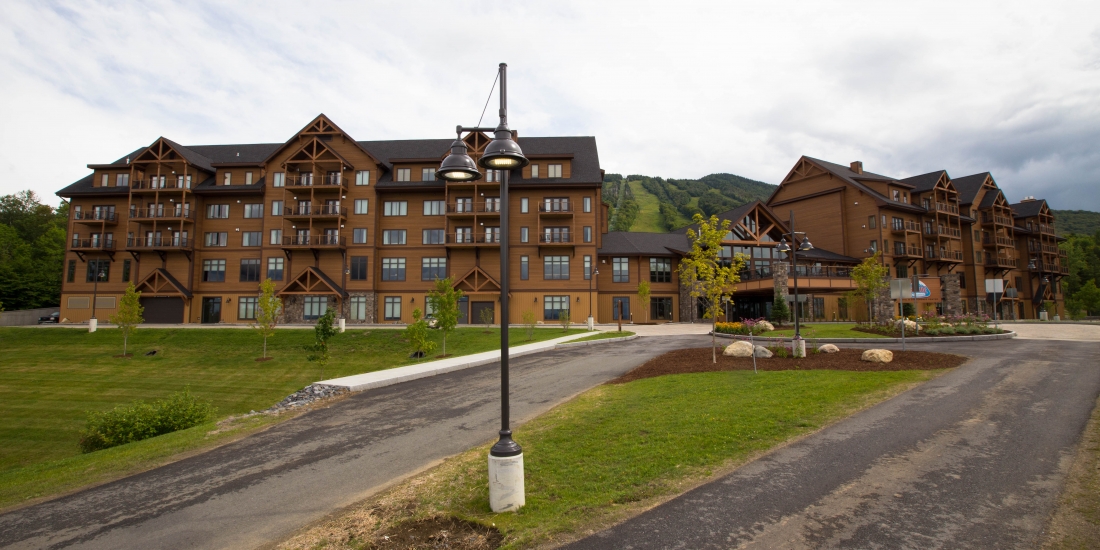
The host hotel was the fairly new (2 years old) Burke Mountain Hotel midway up Burke Mountain. The second transition is further down the mountain, with the run doing 2 loops on trails up and down the mountain, and the finish being right behind the hotel itself.
The race gave out a discount code, so the price of the hotel was significantly less expensive than many hotels at IRONMAN races, that jack up the price for the race weekend. On top of that, the room was great - we had a studio room which includes a small kitchen and cookware, great for keeping cost down as well as having familar food around an event.
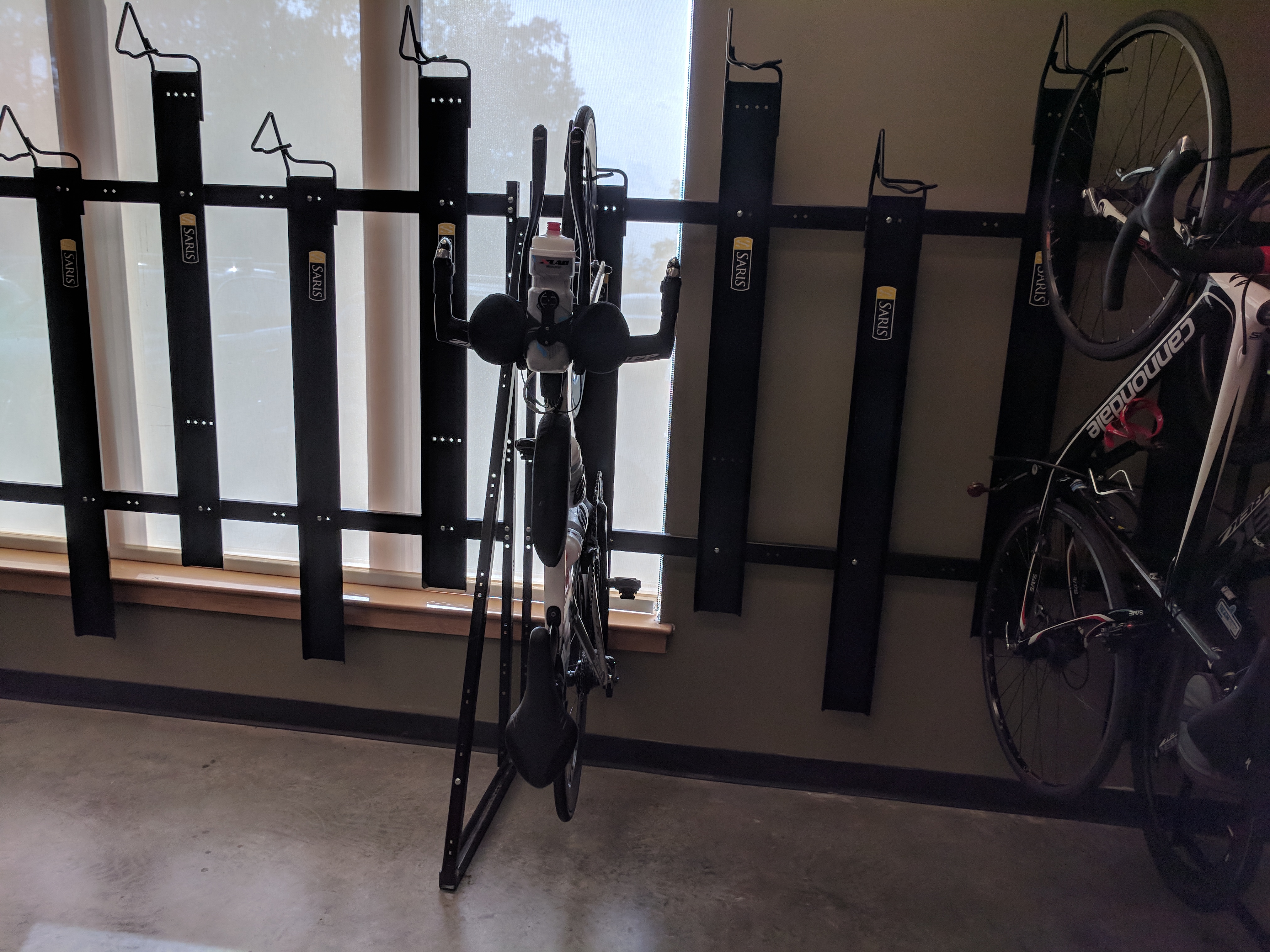
Oh, and I have to mention that when I checked in and started to walk away with my bike, the front desk hotel worker let me know that bikes go in a bike room down the hall on the first floor. "Huh, we'll see how this is." I thought, having not experienced that anywhere else. Holy smokes, this hotel knows their demographic, with so many mountain bikers staying there. The bike room was huge, with key card access and bike racks in every direction. A great place to be able to store things without having to shuttle bikes in and out of elevators.
Check-in and Pre-race Meeting

Check-in was quick and painless, no USAT required, with just one stop for everything. You check in with your whole team if you're doing a relay, as well as your support person, and show that you have the safety gear required for the race - front and rear bike lights, headlamp, hydration pack, phone, and battery pack/charger. Window clings are provided to put in the support vehicle to help distinguish who's involved in the race.
The pre-race meeting took place the night before the race at the ski lodge where check-in was located. It reviewed each course, with the need to know information and focus on certain intersections to take extra caution at. The bike course is open to traffic, and intersections are not manned by police, so follow traffic laws as you would on a training ride. A GPX file was also provided of the bike course so you could load it onto your GPS device for an extra map, in addition to the on-course signage for turns.
The run information focused on safety, too. With so much elevation gain (6,000ft over 2 laps) being at the start of each lap, we should expect it to be speed hiking more than running early on. Also, as it got later into the night, with a sparce number of people on the trails, be aware of wildlife, make some noise and consider wearing a bell. Support people running with the competitors is encouraged, and required later in the night.
Race Day
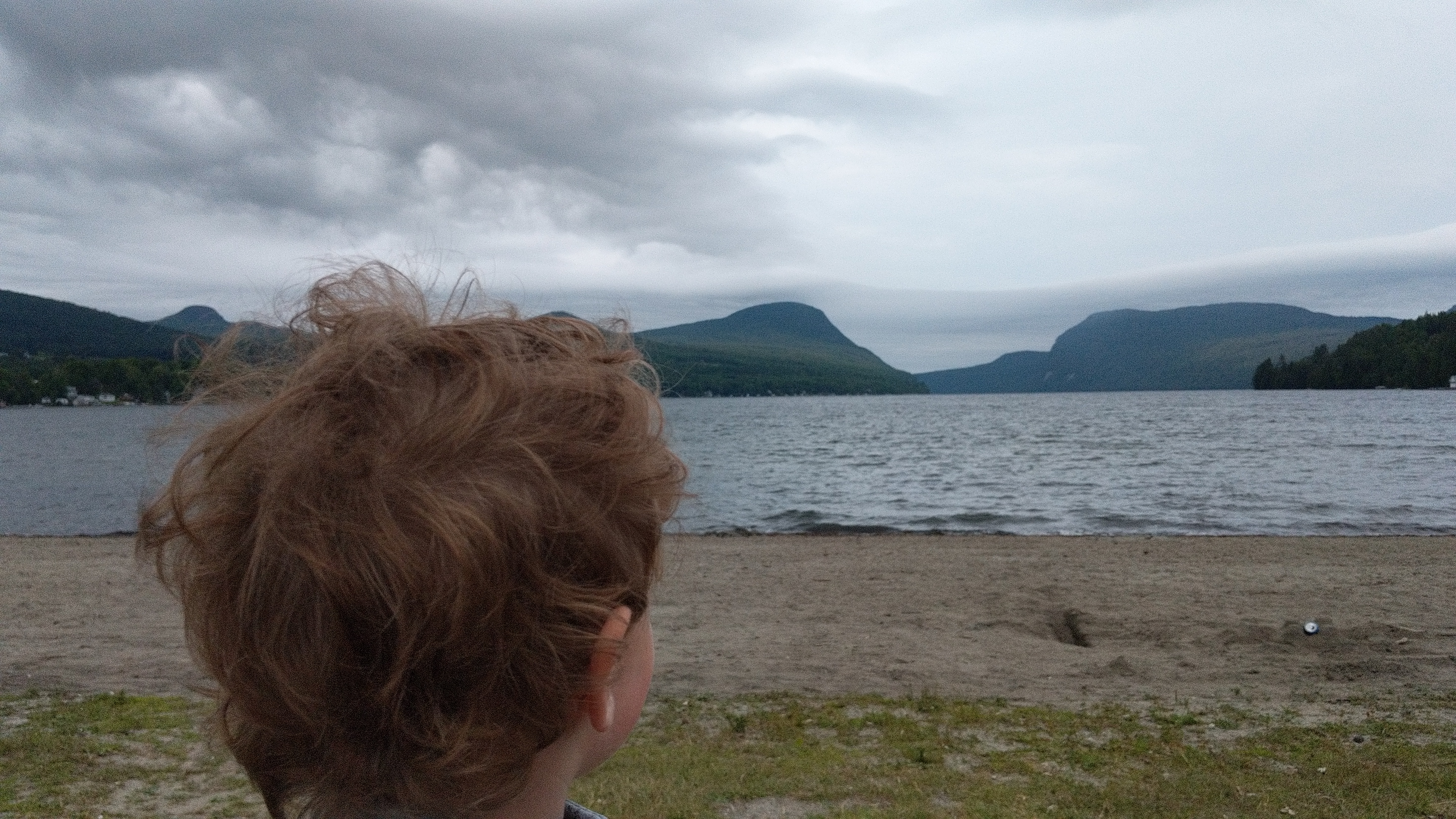
Transition 1 opened at 4:30am on race day, so I had set my alarm for watch's vibration alarm for 3:30am with plans that Sarah and I would head over and let my 3 year old son Simon and wife Betsy sleep. Simon was having none of missing out on anything, though, and woke up when I did and demanded to come. We all loaded into the car and headed to Lake Willoughby - the deepest lake entirely contained in Vermont with a max depth of 320ft, and thus, pretty darn cold. The swim for this race is wetsuit mandatory.
The swim start is on a beach there, with transition across the street and parking right next to it. It couldn't be simpiler to get in and set up. There are also the beach's port-o-potties right next to transition for before or after the swim.
Competitors got a green wristband, while support people got a black wristband, and that allows both to come into transition. That's important because transition 1 and 2 are not in the same place, and transition 1 must be packed up and broken down once the competitor is on their bike. So have your support person come into transition when you set up, and when you get out of the water, so that they know what is yours and can pack it up for you.
The Swim
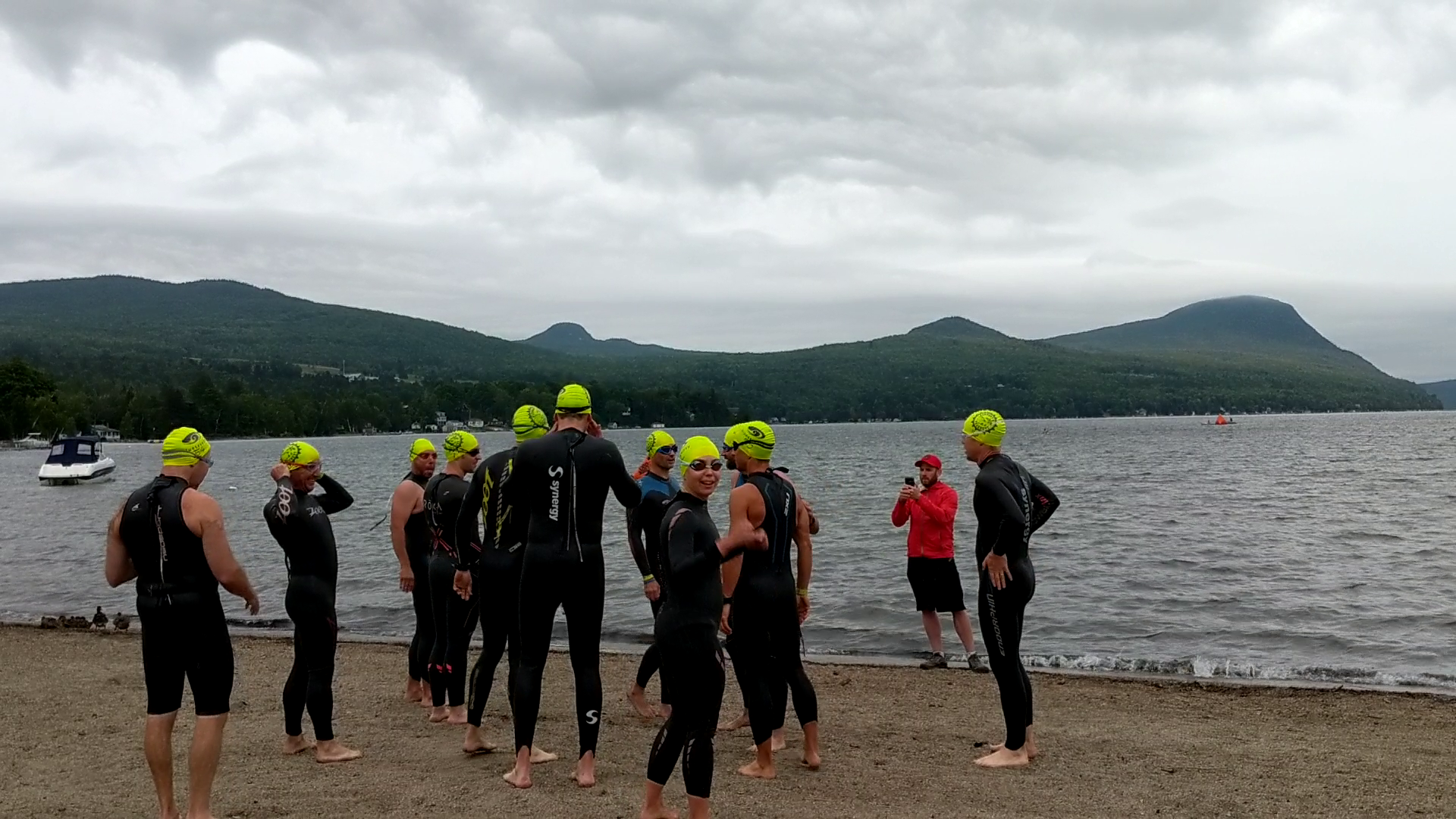
Did I mention the race day weather? No? Oh, right. So it's in the 50Fs to start, very windy, and starting to rain.
Being so windy, the water in the lake was very choppy, to the point where the swim turn buoys were being pushed out of place to an extreme. Originally the swim was intended to be 2 loops of 1.2 miles, then was reduced in the days leading up to the race to 4 loops of 0.6 miles, since it wasn't going to be too crowded and that allowed better coverage with the number of kayak volunteers they had.
But, on race morning, that wasn't going to happen. Buoys were getting knocked out of position by the wind and rain, to the point where one was knocked over to the shore pretty far off course. For next year they should probably look into what's used to anchor buoys in ocean swims rather than standard lake ones.
They were able to anchor buoys a bit better closer to the shore, so they on the spot decided to make the swim 8 shorter loops rather than 4 - whew, a bit dizzying, but manageable.
The swim was clockwise, starting with swimming straight out into the lake to the first turn buoy. The waves were fairly high and strong, reminding me of an ocean swim. Depending when you looked up to sight, you might not even be able to see the buoy with a wave blocking your view. The waves were so short and rocking up and down that I was feeling a little sea sick early on for the first time in a swim.
After the first turn buoy though, that feeling lessened, and sighting the second turn buoy was much easier, it was anchored next to a boat which gave the additional object to sight. You just need to either time your breathing to the left carefully, or breath to the right to avoid a face full of water fairly often.
As the swim went on, the buoys were steadily being knocked closer to shore. By my 4th loop or so, after the second turn buoy swimming across the shore by hands were almost hitting the bottom, and some folks were opting to get up and run across that part of the swim. I was pretty against doing that, and while I was almost certainly slower not running it, I wanted to test out some swimming changes I had been making this year working with Stacy at Sweetwater Swim Studio as much as I could before Lake Placid the next week.
As I came around the start buoy on each lap, I was standing up and giving a finger count of my lap to Sarah and Betsy, to give them an idea of where I was and give them an opportunity to correct me if I was miscounting. This also gave me an opportunity to glance at my watch and see what my distance and time was each lap. As I finished lap 6, I looked at my watch and realized I was already at 2.4 miles, at the 1 hour 10 minute time I was aiming for - but I still had 2 laps to go.
When I finished my 8th lap, I was at 2.95 miles - my longest swim to date! Coming out of the water my support crew was ready and waiting, and off we ran to transition.
The Bike
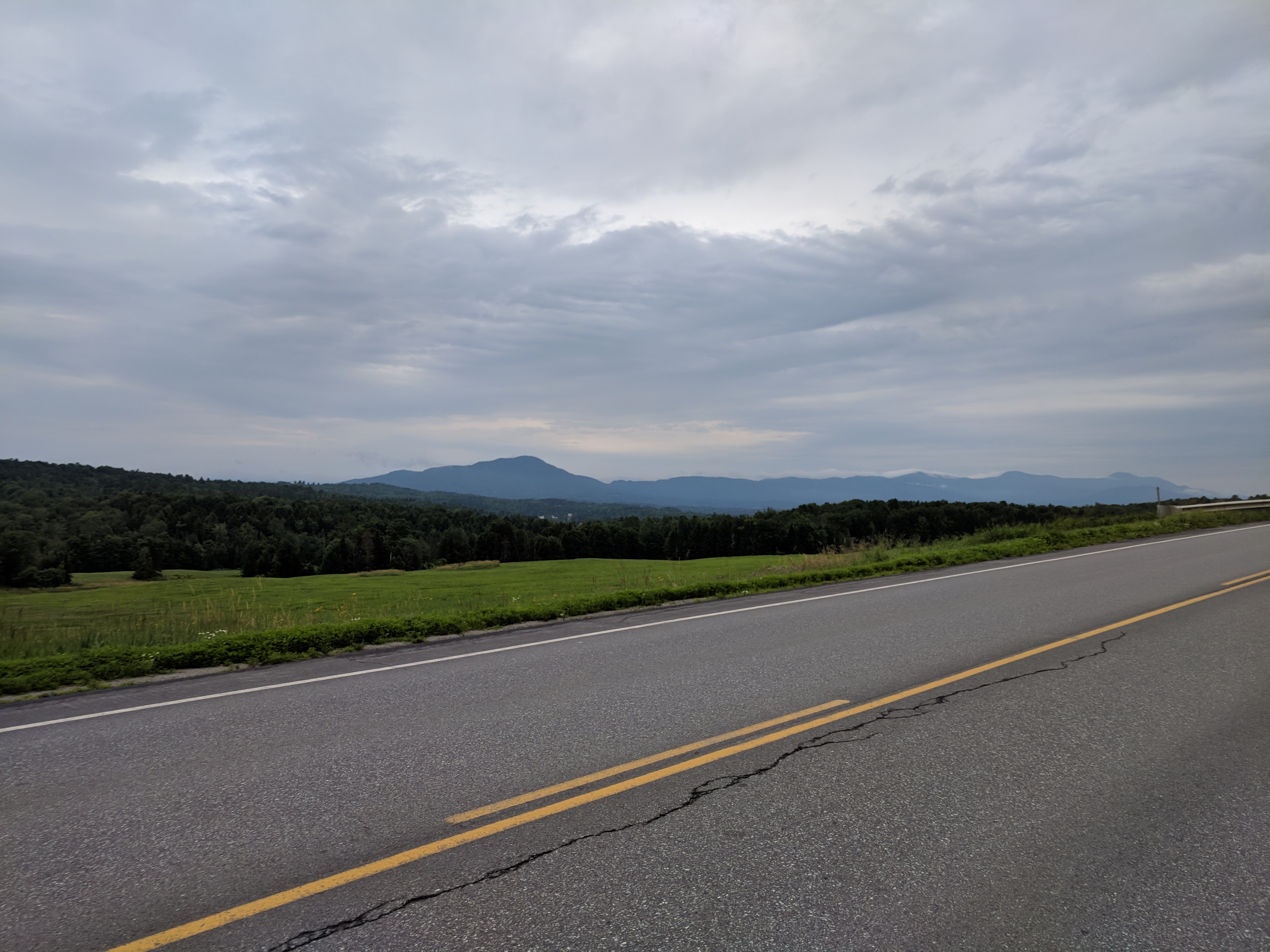
By the time I was out of the water and getting on the bike, the rain was getting noticeably heavier.
The bike course starts at Lake Willoughby, goes out and does a lollipop coming back through Johnson College and ending at transition 2 at Burke Mountain.
I had been debating whether to ride my road bike with disc brakes and 28c tires, or to ride my time trial bike that I usually use for triathlons, which has rim brakes and 25c tires. It only took about 15 minutes for me to regret using the time trial bike.
The course has around 8,000ft of elevation gain, but it's not gained in just a few big climbs, it's frequent up and down, which meant a lot of descending on wet curvy roads in the rain, disc brakes and wider tires would have been nice. I'd probably go with my road bike in the future, but in dry conditions either bike would be fine for this course.
I used the GPX file provided by the race to have navigation on my Garmin 520, if for nothing else than to get a heads up that a turn was going up soon and to start looking for the race signs.
There wasn't a ton of traffic on the course, but I was using a Garmin Varia RTL510 which is a super bright tail light (my wife said she could easily see me a mile away) and also a radar letting you know on your head unit when a car was coming behind you, how far they were from you and how fast they were coming. If nothing else, it's actually more useful when traffic is quieter so you don't get complacent, and is nice to have an extra way to know if traffic is behind you when descending so you can use some more of the road. It was fun that many of the cars passing were actually support vehicles for other riders, giving honks, cheers, and words of encouragement to everyone along the way.
For the most part the roads were in good condition - a couple spots didn't have much shoulder, and one stretch of road down at the head of the "lollipop" was in pretty rough shape - lots of potholes that made it impossible to be in aero position.
Once past that, coming back was fast - there's a long fast downhill that's mostly straight, and you really cruise. Getting close to the lake again the wind really picked up, and slowed things down - a mix of headwind and cross winds knocking you around made it more of a challenge.
Coming back through East Burke, VT is a fun ride with lots of bike minded people around. You head up and over Harding Hill, then come through town and up to the base of Burke Mountain to transition 2.
Overall, the bike course was really enjoyable. It's quiet, hilly, New England roads at their finest. I carried 3 water bottles with me and met with my support crew to refill them around miles 30, 50, and 78 for refills. The police were really clear they did not want any support vehicles partially on the road, so those mile markers had good places to stop - a gas station, Johnson College, and an elementary school.
The Run
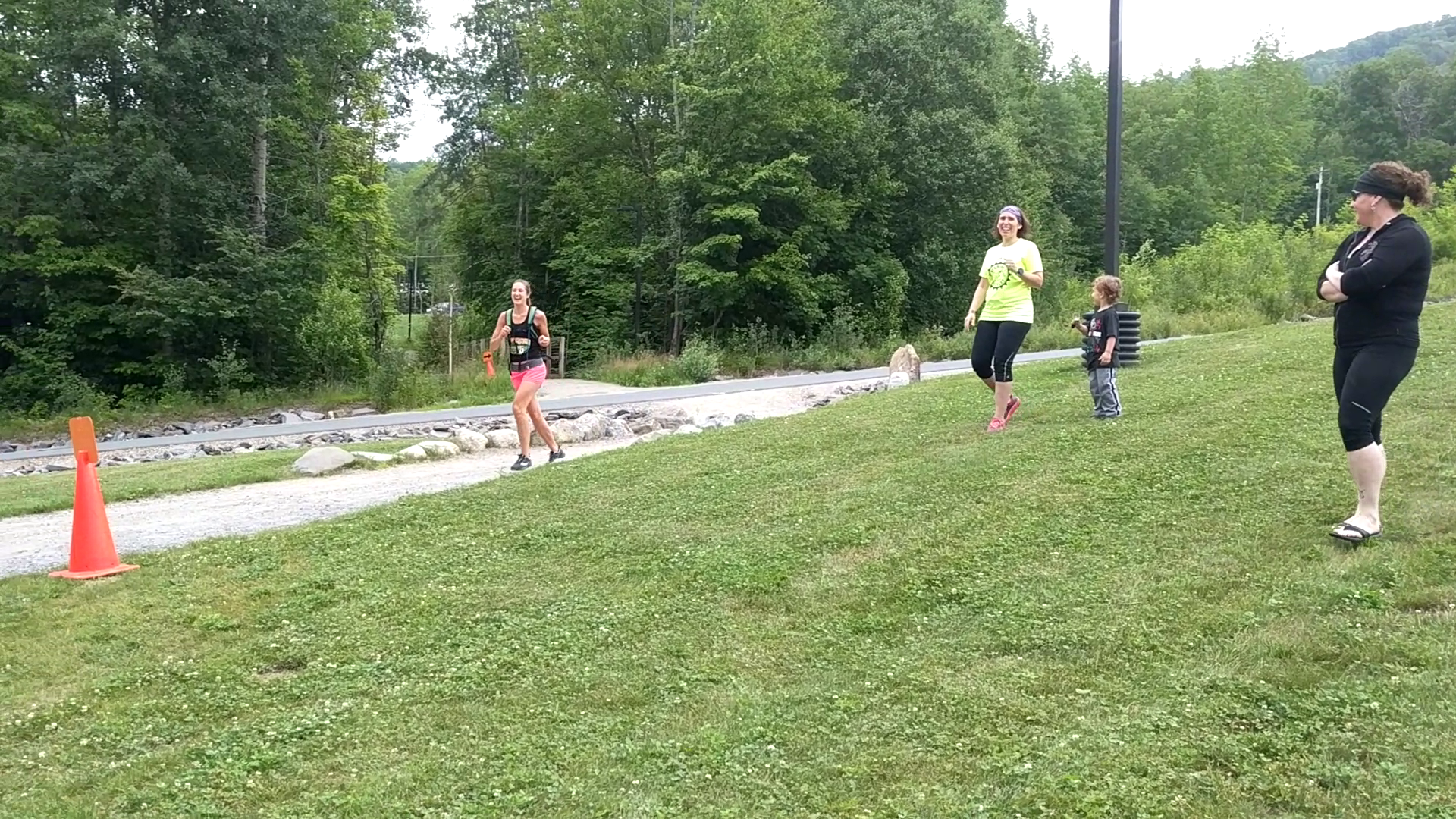
Sarah here! Here's my take on the run course of the event.
The run portion of the race was a lot of fun! But I only did the run, I’m sure the people who did all three events would have a different word to describe it! The run starts by crossing the dirt parking lot and enters the woods at the trailhead of the Red Trail. This trail has a gradual incline at first but quickly gets steeper and steeper. The trail eventually switches to something you can really only hike, due to large rocks that require higher steps and hands (occasionally). Eventually you reach the summit and head down the toll road, which has a lot more switchbacks than what’s marked on the map. Eventually at the bottom of the road (just before the gate) there was a sign bringing me back onto a trail.
The course goes so far down the toll road, I thought I had missed a turn somewhere! But I didn’t, I just learned that there weren’t a lot of signs marking the course. From the road, the trail serpentines through a field with tall grass with a gradual incline. It then leads back into a wooded area with some ups and downs (definitely run-able - at least for the first lap!). Next, it comes out behind the Kingdom Farm Lodge and goes down the gravel road for a bit. This was a nice break for my legs, as it was pretty flat. The course then leads back onto a wooded trail (Trillium) that eventually leads to another gravel road. This road comes out on the main road leading up to the Burke Mountain Hotel, but instead of heading that way it goes back towards T2, takes a left onto another gravel road, back in the woods and up a grassy field. It then comes back out onto a gravel road with a pretty steep incline up to the hotel. This is where you’d switch runners or keep on going. The second loop is a little bit longer, because you have to run around the bottom of the chair lift and back down to the Red Trail. The first lap took me 2 hours and 14 mins and the second lap took me 2 hours and 44 mins.
I thought this course was awesome, it really challenged me mentally and physically! It was challenging being out there on my own (I think I only saw 5 other participants the entire time) and knowing that if I didn’t keep up my pace I could end up running in the dark. And also knowing anything that was difficult in the first lap was still waiting for me to face again, but with more tired legs in the second lap. I loved the variability in terrain and thought that the course was very doable. The most challenging parts (in my opinion) were in the first 5 miles of each loop (up and down Burke Mt.), I was expecting the whole course to be like the first 2 miles of up so I was pleasantly surprised after my first loop. For the future, I would like to see the running course be 26.2 miles (this was 24 miles, my phone died and stopped tracking after 22.5). Not because I wanted to run more, I certainly was ready to be done, but it’d be nice to be able to call it a marathon.
Overall, I felt the race was very well organized and everyone was very helpful and supportive. I’m really glad I got the opportunity to participate in such a unique experience!
Note from Dan: We used Strava's beacon feature for Sarah's run, so we could see where she was on the trail and get an idea of when she would be coming through. The mountain has good celluar reception on it, so it worked pretty well. I only wish it showed what her current pace as well. Garmin's Livetrack feature would also be a good option.
The Support Crew
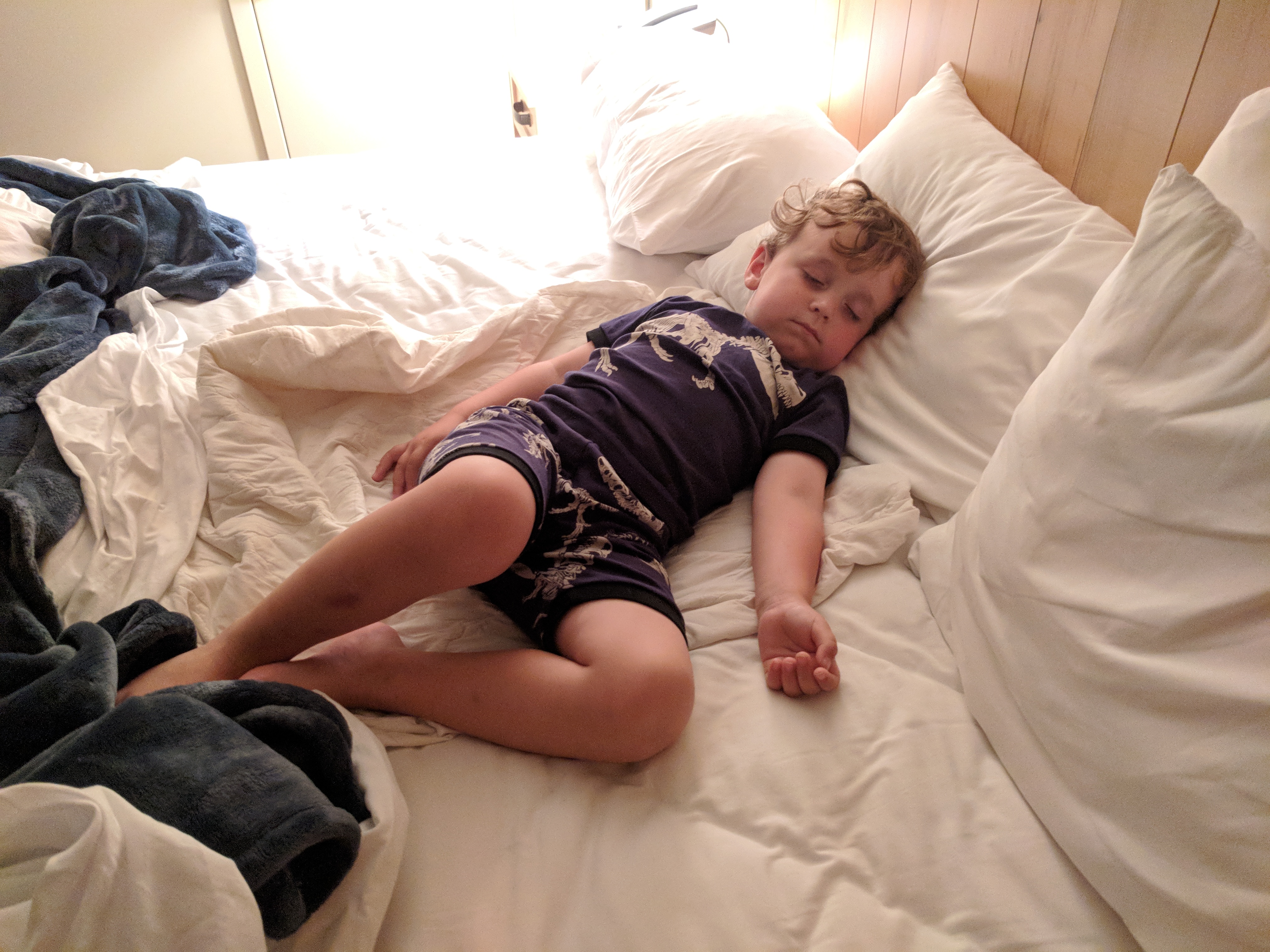
Being part of the support crew was exhausting work. Here's things from Betsy's perspective:
Let’s get the honesty out of the way- I was opposed to this idea when my husband first mentioned it. I was against the idea pretty much right until we arrived (hadn’t told him that yet. Sorry Dan). It sounded like too much. One race too many. We had other trips/races that had been planned for a while and it just sounded to me like one more race on the pile and not an easy one to squeeze in at that - travel, packing, high intensity all around. So now here I sit, fork in hand, with my serving of crow with a side of humble pie. This is not just one more race. This was something very different. I was right about it being a lot of work but it was energy well spent.
More honesty - the responsibility of providing support along the course made me nervous. I’d never really been the support crew for a race before. Well, that’s not entirely true. I’ve worked aid stations at triathlons. I’ve gone to many lengths to plan out pre-race meals for the family on the go. This was likely the next reasonable step but I was a little intimidated by it. I didn’t know the area. I’d have a 3 year-old in tow and you really never know which way those winds are going to blow on a given day. I wasn’t even sure my son and I would be going until a few weeks before the race. Because of what we’ll now call my late blooming enthusiasm for the event, I hadn’t even looked at the routes or guidelines until we arrived. In the early planning stages teammate Sarah had other friends going who would handle support. In the end, while I was initially opposed to going to the event, it turned out I was more opposed to letting anyone other than me be the support crew.
I have to say, I’m so glad we did go because it was a great chance to be a part of a really unique event and we had a great time all around.
Accomodations
We stayed right on site at the Burke Mountain Resort. Not only was it a beautiful place to stay but it made a lot of the pre and post race elements so easy. Comfort counts at races, whether you are the athlete or the support crew and this had a lot of built in comforts. Providing support for races always includes a focus on food for us. Trying to figure out dinner the night before an event in an unfamiliar location when everyone is already tired from traveling is never a good time, and after the event no one has the energy for such things. Our family tradition is breakfast for dinner the night before a race and oatmeal the morning of. Staying at the Burke Mountain Resort made this so easy. We’ve been at events where I’ve been cooking on an electric griddle and washing dishes in a dish tub in the bathroom. At Burke, our deluxe studio suite with a kitchenette was a treat. It was nice to be able to warm up our waffles and breakfast potatoes that I’d pre-made at home and cook some eggs while we made race day plans for support stops on the bike course. I even had a kitchen counter to set up the rice cooker for oatmeal on race morning instead of on a dresser, desk, or bathroom sink.
Our 3-year-old really loved the room too. The cool keycard light control feature, a bathroom sink he could easily reach on his own, and enough room to feel like he can spread out an play. All little things but when you are 3 and on the road, little things can become big things pretty quickly. Of course, the next time we stayed in a hotel a week later he couldn’t stop commenting that the room was “so small”. I think Burke really spoiled him.
All three of us enjoyed the balcony. It was a great view of the mountain but it was also overlooking the patio and the race finish line. This meant there was plenty to watch right from our room. From the pool with well kept locker rooms to the in-house food options to the always pleasant staff, Burke Mountain Hotel was a great experience for the whole family and the cost for race weekend was the most reasonable we’ve seen in a while.
Race Day Support
As reluctant as I might have been before arriving, as soon as we were at the event I was in. It was clear how personally invested James, Jason, and Audrey were in making this a great experience for all involved. After the pre-race meeting we headed back to the room to make plans for meeting spots on the bike course. My nerves kicked in and I was unable to sleep until I had studied the course, mapped it out on my phone and restructured some stops. Not only did we need places to meet up with Dan at particular distances along the ride but I had to factor in some level of fun for the little guy as well. Luckily there were full maps and descriptions on the race website. There’s a lot of driving for the support crew at this event. There’s no way around that. We had a half hour to the swim start and then a long trek out to the 50 mile mark on the bike. Everything was pretty easy to navigate, well marked, and there were plenty of good spots along the way to meet up.
We initially weren’t sure if we would be going to the swim start or if teammate Sarah would handle that portion of the day but, when 3:30 a.m. rolled around and Simon sat up in bed and announced he was ready to go to the race, we were all in.
The beach area at Willoughby would be a great place for shovels and pails but it was a cold windy morning. We settled for watching a very people-friendly duck family and a playing few rounds of UNO until it got too windy. The location made it easy to cross the street to the parking lot and sit in the car and watch while hands warmed up, and then get right back out there. There were also ample porta-potties and bathroom stalls at the beach which is key for support crews. It was helpful that support people were allowed into transition to gather the swim gear and clean up - everything had to be out since we weren’t coming back. I think it also contributed to the feel of the event. This was a team effort all around and you could see and feel that message throughout. We put the swim gear in the car, stowing the wetsuit flat in the Yakima carrier on the roof, and headed out.
This was a fun event to cheer at. With such a small group of racers, you got to know the faces of other athletes and support crews. While time was a motivating factor, you could also feel the vibe that it was all about each participant running their own race against the challenge of the course. There was less of the hectic feel of some races. People had time to smile, and cheer each other on.
After the swim we made a plan to take two cars to the checkpoint on the bike course. This meant Sarah could celebrate along the bike course but still get back in time to get out of the car and prepared for her run while Simon and I stayed on the course to check in with Dan around the 80 mile mark. From the hotel, we were able to hop on the highway and catch up to the bike course around mile 20. I was using a combination of Garmin LiveTrack and Google Maps Location Sharing to follow Dan on the route. There were plenty of times that either he or I would lose signal but it would pop in often enough for me to have an idea where he was on the course. There’s a lot of pace calculating and time estimating involved in making sure your aid stops are where they need to be. While we hadn’t planned it, we ended up catching up to Dan in Lowell just before the turn onto Route 100 so shortly after that turn we pulled into the parking lot at the Lowell General Store 25 miles into the course. It’s a great stopping point on the right hand side with plenty of room to get off the road and lots of open frontage to see riders coming. This worked out well as Dan was ready to refill some water bottles at that point. Having everything laid out on the front seat- jugs of water, powdered drink mix, and extra gels- made the stop quick and easy. I would definitely plan this stop in next time around. We then to the 50 mile check point at Johnson State College. This put us there ahead of any riders which gave some time to stretch legs, kick around a soccer ball, and let the kiddo ride his own bike a little bit. Once again, with such a small group of participants, it was easy to get wherever we needed to be. We set up our provisions right next to the road so that it was another quick pitstop for Dan. Riders who didn't choose to stop could just all out their number and keep riding. After Dan got back on the road the support crew was ready for its own pitstop- there were no bathroom facilities right near the checkpoint but I’m sure something could be found on campus. We opted for a quick trip to a Mobil station 5 minutes away in town for a snack boost and bathrooms.
For the last aid stop on the bike course we were looking for something around the 80 mile mark but I was trying to think of the kiddo. I knew this would be a long day in the car and wanted to reward his patience. The night before the race, when I had been studying the course I found the Irasburg Village School at the 78 mile mark. A quick Google satellite check showed what looked like a playground out back. A few minutes in the sandbox away from the car was definitely needed at that point. I think he just enjoyed having a big open field to get out and walk around in. We couldn’t see the racecourse from the playground so I was relying on the Garmin LiveTrack and Google Maps Location Sharing again. The school made a good aid stop being on the right side of the road with just enough frontage to watch for riders. The opening to the lot did have some loose gravel and sand though so that’s something to watch out for.
An observation as a driver on the course: While I did see most riders lights eventually, I could pick out Dan’s Garmin Varia RTL510 from an impressive distance. I always knew I was coming up on him long before I could recognize the kit. Every rider should have a light that noticeable on the back every time they are on the road.
After that it was back to Burke to wait for Dan to finish and cheer Sarah on for the start of her run. Hopping on the highway got us back with enough time for a stop at the hotel room to regroup and restock on snacks. From there it's a short drive down to the transition area where we hung out, kicked the soccer ball around a little more, and made some noise for the other athletes.
Sarah was off and running as soon as Dan was in from the bike course. After checking in with the race crew we headed back up to the hotel to grab some lunch at their pub style restaurant and wait for Sarah to finish her first loop. We had the easy job now- hanging out at the hotel while Sarah made her way up the mountain. We used Strava Beacon to track Sarah on her run. This worked great and we were ready to refill her water and cheer her through to her second lap. She had thought ahead of everything she might need packed in a small bag so it was easy for her to decide when she came through. She was goign strong and didn't take much other than the water but it's always smart to have those extra gels on hand. Then we were able to hang out on the patio, go back up to the room, play on the lawn, or hang out with the race organizers to learn more about them and the planning behind the event.
Reflection
Race details aside, I just have to share some personal reflections on the experience. It really was more of an experience than a race. We’ve been to a lot of races. We’ve been to plenty of well organized races. This was not just a race. I can’t say that enough. I’m sure my husband told me about the organizer James Lawrence ahead of time but frankly I hadn’t paid full attention. The three year-old gets the lion’s share of that most days and like I said, it took a while to warm up to the idea. That meant I had almost no idea who these people were that I was talking to all weekend. But it also meant no assumptions or preconceived notions. By the end of the event I just thought it was super cool to be at a race where I could chat with the race directors, see them kick a soccer ball to my son and offer high fives, be close enough to see them work out hurdles along the way, and watch them get super excited for each and every athlete - following their progress and cheering them on by name. Later, when I got up to speed on who this Ironcowboy was, part of me wished I had a clue who I was with but then I’d probably worry about some silly embarrassing thing I’d said or have felt like I couldn’t just talk to them all. James, Jason, and Audrey were all so great to work with. I was quickly impressed with how the race crew handled unexpected challenges like the wind stealing buoys on the swim course and making sure runners were on the right track. I’ve worked half irons run by Ironman and yes they can organize a huge event like nobody’s business. But I also used to work events in New Hampshire run by a group called Endorfun Sports that had a more personal feel. With this event by Ironcowboy Racing I was back in that personal atmosphere. The goal of Vermont’s Toughest felt more like it was about making sure each participant had a unique chance to challenge themself and enjoy their own success. Yeah they kept times and showed results at the end but I watched these directors and athletes and they didn’t seem to be competing against each other so much as they were competing against the course, completing their own inner race. I’m so glad we were there for the first Vermont’s Toughest and their enthusiasm gave me a goal to get back to pedaling myself and prepare to ride the bike course next year.
We topped off the weekend with a stop for breakfast at the Northeast Kingdom Country Store in East Buke, some riding for the little guy at the Kingdom Trails pump track for new or young riders, and then ice cream at Ruby Lee's. Burke really is a great place to visit for the whole family.

Overall
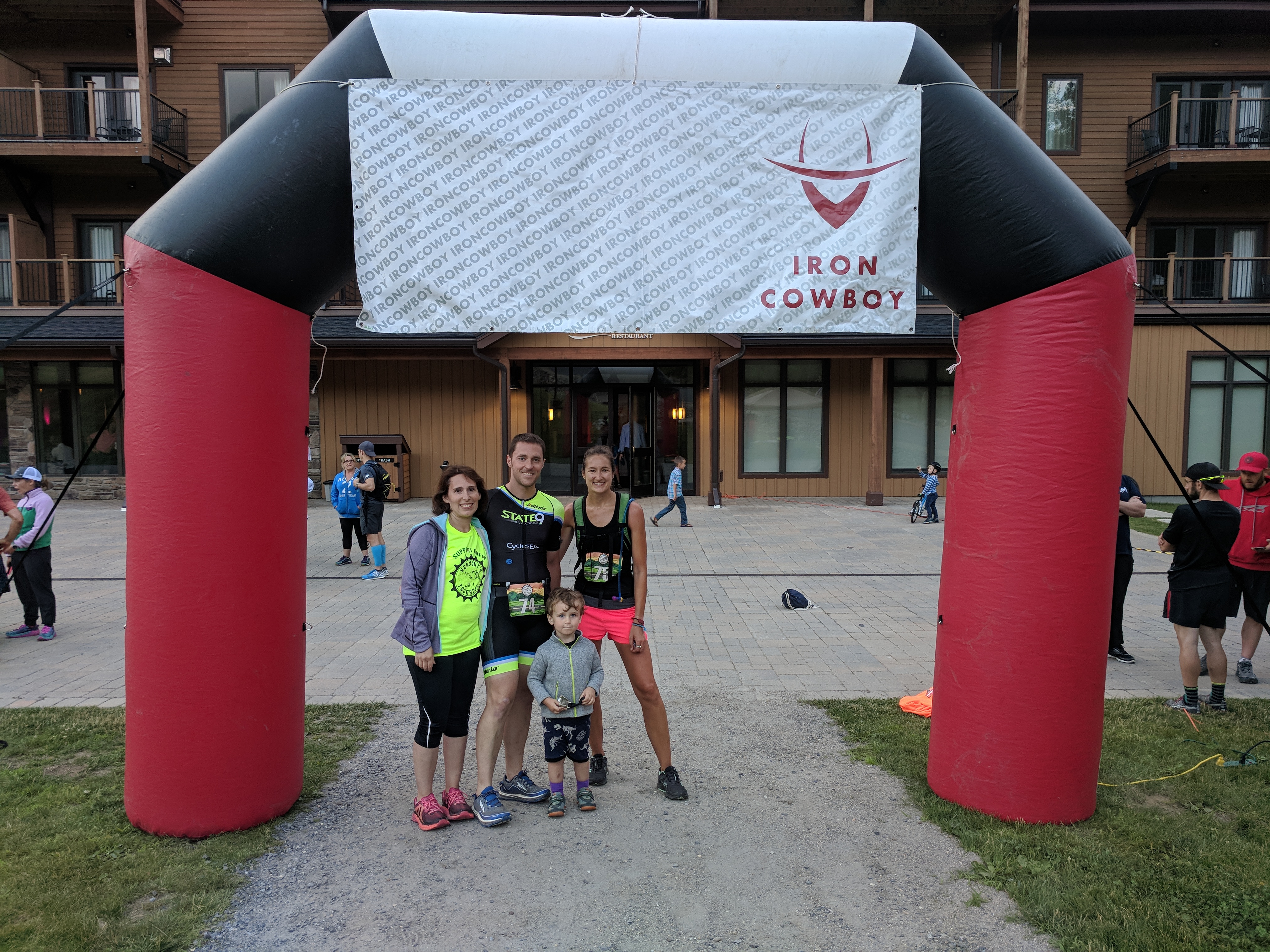
Overall the race was a ton of fun, with a very different "grass roots" vibe compared to other full distance triathlons. The self supported aspect of it meant people who would normally be spectators at other races were really involved here, and that just added to a "we're all in this together" feel to the whole thing.
Don't let the atmosphere or beautiful scenery fool you though, the course is no joke, especially for an invidiual athlete. It's a challenge, and you'll need all those positive people to help you get through the day.
The self supported nature of it really lends itself to the team or relay formats as well, because whoever is not currently on course is doing their part to support whoever is. The "team" format is neat one - where each athlete does half of each disciplene, so you effectively have 2 people each doing a half distance triathlon. With Sarah being a strong runner and hiker, we opted for doing a 2 person relay.
This was one of the first triathlons that my wife Betsy really wanted to be a part of in the future. If the 2 person relay option is continued in the future, I could see doing the swim and run with her doing the bike, a neat way for couples to form teams.
So long as we don't end up with outright conflicts, we'll definitely be coming back next year. It's a great balance mentally to other events.
